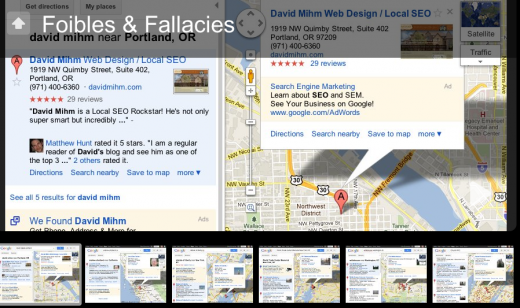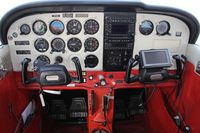Should every place & business that exists in our everyday life be used to sell against? Should that specific, very real entity with its history of sentiment and purpose be leveraged to shill for something without their knowledge? And if so what is appropriate to sell against that place? I asked myself those questions as I explored some of the “bubble ads” that Google was showing in the info bubble for these Places.
When Google Adwords are shown against a full page of search results based on relevancy and various matching type, some of the quirks of the system are not obvious. However when an algo tries to position one ad against a single Place that exists in reality the limits of an algo based placement become more obvious. The lack of upfront human curation creates unpredictiable and oftimes odd outcomes. The results can easily pass from the mundane into tasteless very quickly.
The issue certainly affects small business as they find their competitors both local and national advertising against their good name. In this slide show you will see Google leveraging David Mihm and Andrew Shotland‘s reputation to highlight their own Adwords product as an alternative to either’s service (yea right).
But that annoyance felt by an SMB at Google’s ham handed selling pales when you see Google let someone selling against icons of American culture. A private, for profit tour positioned against the Statue of Liberty seems odd but one positioned against the 9/11 memorial seems downright macabre.
There is humor as well as you see the Obama campaign selling against the Whitehouse with a desire to live there another 4 years. The Yellowpages selling against a church certainly strikes an odd note. But that same humor turns black when you see abortion ads positioned against a Women’s Homeless Shelter or Health Clinic.
Obviously when the level of granularity gets down to the local business or place the foibles of this sort of advertising becomes painfully obvious. It reminds us all that we now live in a culture where every thing is for sale and every white space is ripe for an ad placement. Google’s info bubble ads that are now cluttering Google Maps give Maps the feel of those “park benches” that sit at smogged covered street corners with ads on their backs and facing into traffic. These effectively become the grafiti of our virtual world only they are not painted by rebel outsiders and they are paid for with real dollars. The ads manage to remind us that all too often that the value of humanity has been reduced to the value of the individuals’ “eyeballs” and their willingness to read the message.
Google has taken a technology that not that long ago reminded us of the wonder of online possibilities and defaced it in a way that has smacks of the billboards and signs that all too often covers the walls of public spaces and bombard our senses with commercial messaging at every turn. The only thing missing from Maps to complete its drive to mirror reality are the whiffs of the urine that all too often cover these same walls. Although I don’t doubt that Google would ad scents if there was a way to monetize them.
Obviously not all of you agree with my disdain for Google’s new efforts. But all of you can find the humor and spot the tasteless gaffs of this advertising method. If you find a particularly ironic, distasteful or inappropriate “Bubble Ad” kindly send along a screenshot for my “Rogues Gallery of Bad Bubble Ads”.
Click to view the slide show:

